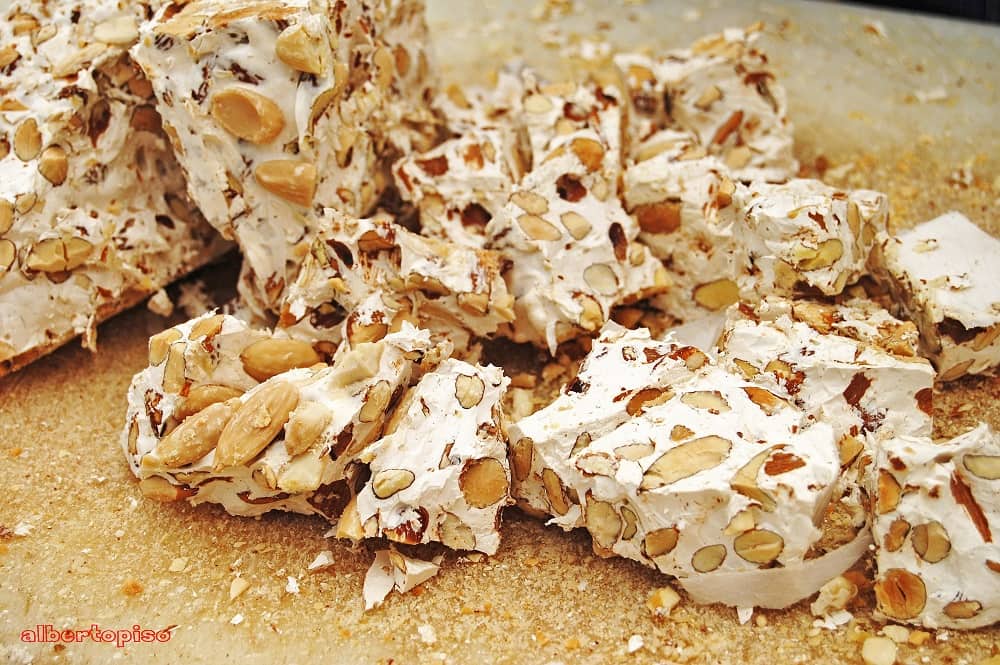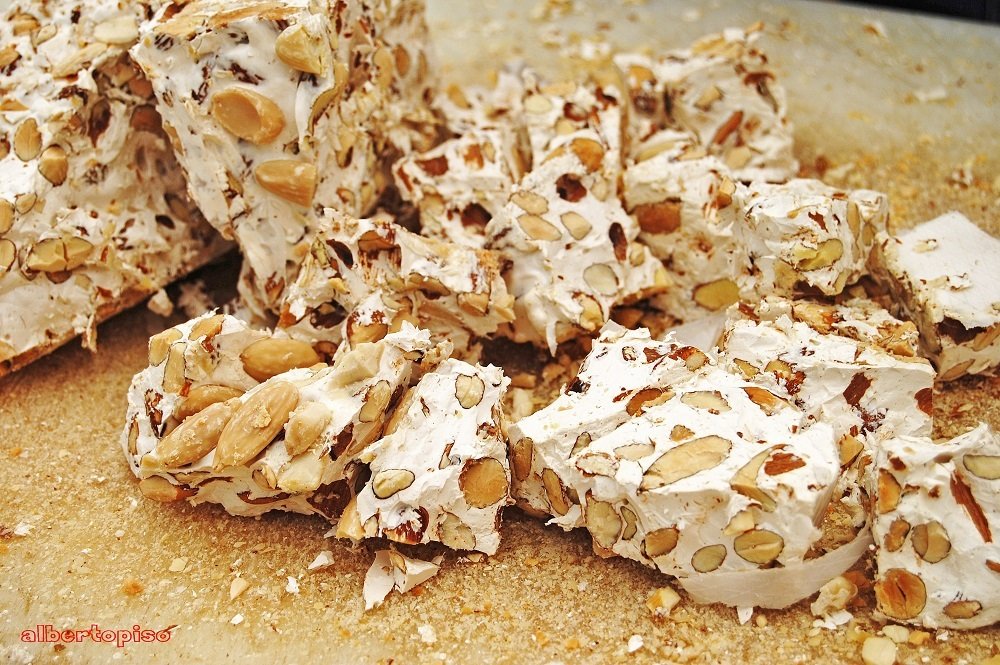Nougat, the sweet and ancient symbol of Christmas.
An essential dessert on Italian tables at Christmas, torrone (nougat) is a speciality with very ancient origins. According to some Roman hirstorians and writers such as Titus Livius and Martial, in ancient Rome, there was a very similar recipe called cupedia or cupeto. It is the same name by which nougat is known in Irpinia, coincidence? Absolutely not. Because it is precisely in the historical region of Campania that this exquisite dessert probably originated. The legend says that after the Roman defeat in the Caudina Valley, the Samnites offered this delicacy to the Romans who, if they survived, would bear witness to their greatness. The cupedia in had the double purpose of feeding the Romans, who were about to die of starvation, as well as consoling them.
This theory, however, contrasts with that according to which nougat originated in Lombardy, and more precisely, in Cremona. However, as mentioned above, it isn't easy to establish its exact origin because torrone is among the gastronomic products of many regions of the world, not just Italy. There are conflicting versions of nougat's paternity as well as and many rivalries. However, nougat is an Arab creation for some people, first arrived in Spain and then in Sicily.
What is certain is that in Italy, this typical delicacy is everywhere, from North to South, in the form of an infinite range of variations and flavours that satisfy the most demanding palates.

The ingredients of classic nougat

The word torrone derives from the Latin torrere -namely, to toast, to roast- with particular reference to the toasting of hazelnuts (or dried fruit inside). The classic recipe calls for some essential ingredients: egg whites, sugar, honey and dried fruit. A quadrinomial transformed into confectionery art with love and passion. Traditional and precious craftsmanship is handed down from generation to generation. Dried fruit is generally hazelnuts, but almonds, pistachios, peanuts and walnuts are also widely used. Nougat is usually covered with thin wafers on the top or bottom.
From this basic "composition", Italian confectionery production has gradually diversified its creations, resulting in as many variations as combinations of ingredients, preferences and tastes. It's soft or hard, chocolate, with a sponge cake filling, crunchy with caramel... let's discover them in the top 5 of the Italian best nougats that we have selected for you.
5. Calabria
Typical of the Calabrian tradition is the Torrone di Bagnara IGP (protected geographical indication) produced in a small town in the province of Reggio Calabria. Its origin derives from the combination of honey and almonds (typical local products) with sugar. It seems that the monks of the Abbey of Bagnara were already skilled confectioners in the 1700s and were particularly specialised in making the "martiniana" variety of nougat.
Although the history of this confectionery production is based on small family-run workshops, the first real factory was opened in the mid-19th century. Bagnara nougat differs from other types of nougat because of the special techniques used and the careful process. The accurate dosing of ingredients, cooking at high temperatures and refining methods give the product its "monk's mantle" appearance (a particular type of roasting). The outside is covered with either granulated sugar or a mixture of sugar and cocoa.
4. Abruzzo
Guardiagrele nougat is also known as aelion nougat in reference to the presumed Greek origins of this small town in the province of Chieti. Very similar to crunchy nougat, it is prepared with whole roasted almonds, sugar, candied fruit and flavoured with fragrant cinnamon. This delicious cake is the subject of an unusual story involving a character from Italian literature. Ignazio Silone, a writer from Abruzzo, was particularly fond of it and used to buy nougat in industrial quantities for himself and as a gift for his friends and relatives. It would seem that the creation of Guardagliele nougat is due to a reproduction of the Campania product. Whether or not this theory is confirmed, this Abruzzo delicacy remains genuinely unique and special. It is still prepared in pastry shops using a special three-colour paper (the colours of the Italian flag) just like in the past.
Another delicacy made in Abruzzo is soft nougat with chocolate from L'Aquila (torrone tenero al cioccolato aquilano), a variant made with hazelnuts, cocoa, honey and vanilla. As its name suggests, it is produced in L'Aquila and is characterised by a relatively soft consistency. It is counted among the traditional agrifood products, otherwise known as P.A.T., recognised by the Italian Ministry of Agricultural, Food and Forestry Policies.
Dulcis in fundo, the soft chocolate nougat of Sulmona. A town in the province of L'Aquila, famous for its confetti (sugared almonds), this town also delights us with this speciality. Made with roasted hazelnuts (no less than 30%), wafer, cocoa, honey, sugar, egg white and vanillin, Sulmona nougat is soft, spongy and intense brown.
3. Lombardy
 o di cremona.jpg)
From a recipe dating back to Renaissance times, Lombard nougat originated in Cremona, one of Italy's main cities famous for desserts and pastry. Its friability is also testified by documents from the beginning of the 20th century that specify it breaks as if made of glass. Almonds, honey, sugar and egg whites are the ingredients used to make this delicacy. True Cremonese nougats calls for almonds to make up 50 per cent of the mixture, honey 40 per cent and the remaining 10 per cent distributed between egg whites and sugar. So, pay attention to the label to make sure you are tasting the original one!
In the past, almonds were used with their skins on, but they are peeled and roasted nowadays. One of its peculiarities is the prolonged bain-marie cooking during which the ingredients are mixed. The mixture is then spread onto very thin sheets of wafer and waits for it to solidify. In addition to the classic preparation, there are many different versions covered with chocolate, pistachios, hazelnuts, and even creams over the years.
2. Sardinia
The undisputed cradle of nougat, Tonara is a municipality in the province of Nuoro, in the historical region of Barbagia. It is said that the Sardinian recipe for nougat comes from Spain, specifically Alicante, a city once dominated by the Arabs.
There are several testimonies to the existence of nougat in Sardinia. There is mention of it in a document dated December 1614 in Catalan (in the Cagliari State archives) which refers to a type of nougat made in Villanova, in the province of Cagliari. The Sardinian author Grazia Deledda wrote about it in her article titled "Gonare" in 1892. Talking about the exhibitors women from Tonara, she reports that they "...sawed the nougats, made by their own hands, with sharp knives...".
This craftwork has been handed down for generations with passion and dedication, characterised by first-rate ingredients and slavishly followed production methods.
The centuries-old tradition of Tonara nougat is based on the trinomial: almonds, honey and egg white. The scent of genuine Sardinian honey envelops the roasted nuts like an embrace. There are varieties with pine nuts, hazelnuts and citrus peel, but the Tonara variety is unique for its aroma. White, soft and truly exquisite: a delicacy not to be missed!
1. Campania
.jpg)
Campania, especially the Irpinia and Benevento areas, is the home of nougat par excellence. If we want to suggest an itinerary to discover the delights of Campania, we should start from Ospedaletto d'Alpinolo, a small municipality at the foot of Mount Partenio. The classic recipe, simple but valuable, is made using ancient artisan methods and involves the use of local raw materials: honey, hazelnuts, egg white and wafers. This typical nougat is also linked to the tradition of the pilgrimage to the Sanctuary of Montevergine, with chariots and horses festively decorated to honour the Virgin Mary.
The next stop is Grottaminarda, also in the province of Avellino, where we find spantorrone. It is a type of crumbly nougat made with honey and egg white mixed and heated for several hours. Then, walnuts and hazelnuts flavoured with vanilla are added. The mixture is then poured into moulds and covered with slices of sponge cake soaked in rum and Strega liqueur (typical of Benevento).
Throughout the province of Avellino, pantorrone is widely produced. Basically, it is made of nougat and sponge cake, alternated in layers, and covered with dark chocolate. It is madewith eggs, sugar, flour, honey, almonds, vanilla flavouring, Strega liqueur (or rum) and cocoa for the outer covering. It is cooked in a bain-marie in the traditional "torroniera" (a professional nougat production machine). The nougat factories in the hamlet of Dentecane, in the municipality of Pietradifusi, are very famous.
Bagnoli Irpino, Cassano Irpino and Montella, where chestnuts are cultivated, are famous for chestnut pantorrone or spantorrone. This kind of nougat is made from a classic mixture of honey, egg whites and icing sugar. Furthermore, it is enriched with a filling of chestnuts (either candied or in the form of a paste) as well as cocoa and rum.
Finally, in the province of Benevento, we can enjoy traditional torrone made with egg whites, honey, hazelnuts and almonds in both soft and hard versions, white and chocolate, with almonds or hazelnuts. Among the many towns in the province famous for producing this delicacy, Santa Croce del Sannio and Montefalcone di Val Fortore are undoubtedly worth mentioning. Not to be forgotten is San Marco dei Cavoti, known for its delicious crunchy nougat covered with dark chocolate.
Tradition, raw materials, passion and dedication, melt together to create goodness that respects artisanal and genuine production. Technological progress and innovation, new tastes and assortments will never betray the old recipes.
At the end of this journey through flavours, have you chosen your favourite nougat?
About the author
Written on 02/11/2021



Alessandra Festa
From North to South, a journey through flavours, passing through the centre and the islands, to discover nougat. A typical Christmas dessert, it is a typical product of Italian gastronomic tradition.